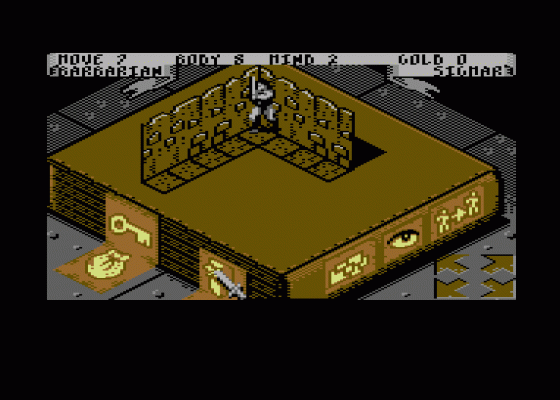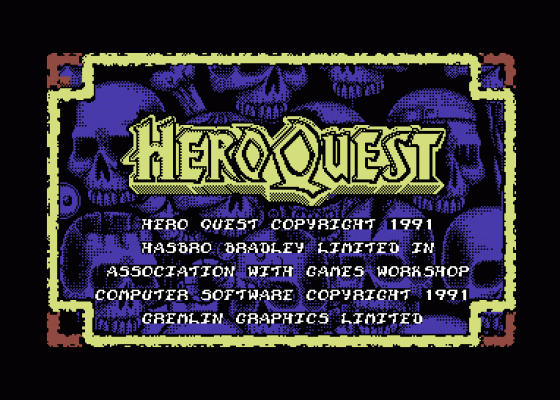
Commodore Format
 1st June 1991
1st June 1991
Categories: Review: Software
Publisher: Gremlin
Machine: Commodore 64/128
Published in Commodore Format #9
HeroQuest (Gremlin)
The biggest board game hit of 1989 finally finds its way to the C64, courtesy of a deal between Gremlin Graphics and Milton Bradley. Our reviewer sharpens his blade on a few of its bad guys, creeps down its corridors and finds his way back in time to file this report...
It's dark down here, And damp. It's hard to keep the torch burning. And though I've been down here for hours, I couldn't tell you what's around the next corner. The things I have to do to write a review... Even my portable PC is running low on battery power. But now I can tell you why I've put myself through this suffering.
HeroQuest the boardgame was brilliant. Its simple rules and open-ended design meant scenarios (the technical word for adventures) could be as simple or as complex as you liked. When you tired of the twelve quests provided, a blank map was there for you to make up your own scenarios. In fact, the game was so neatly done, it was a piece of cake to make up rules, traps and monsters of your own. But there was just one problem, you needed two people to play it. Or at least you did. For now it has been coded onto your dear C64 and the danger awaits yourself alone.

HeroQuest is played out over a series of missions or quests. The goal of a quest can be anything from saving kidnapped VIPs to destroying a whole dungeon full of creatures. All the scenarios together form a whole 'campaign' you have to complete, each quest forming a small part of the total aim. In this game the forces of evil are controlled by the Lord of Chaos, Morcar. In the original board game, one player was needed to act as Morcar. On the computer version, the program itself handles this task. So the plot is simple. Morcar has massed his forces once more and you have to put the wind up him - quite appropriate, we think.
There are twelve missions - or scenarios - to choose from, each one ascending in difficulty. And players of the boardgame think they know the score, they're in for a surprise. Even though the scenarios are much the same as in the boardgame, the maps have been altered to make life more difficult. Easier missions include The Trial and The Rescue of Sir Ragnar, a very simple kidnap rescue: only one trap and monsters so crap they make pedigree poodles look vicious by comparison. But just when you think there's nothing can stand in your way, the scenarios start to hot up a bit.
Each turn you have a choice of options. You can move, fight, look for traps and secret doors or look for treasure. However, you're limited to movement plus one other option.

Searching for traps and secret doors will reveal said items if they exist. If you search for treasure the program either tells you that you've found a special quest treasure or it generates a random find which could be anything from nowt to wads of cash to a wandering monster.
Moving around in the dungeons/castles/fortresses couldn't be easier. A series of numbers flash up on the screen in quick succession. Press the fire button and a random number is created, representing what would normally be your dice roll. You move over this number of squares in one of two ways. You point the cursor at the square you wish to go to or use direction icons.
Coming into contact with monsters means combat. Every creature has a number of body points. Body points indicate how tough you are. The monsters usually have only one body point, do hitting them kills them unless they successfully defend against your blow. You only have to defend if the monster actually attacks and you have more than one body point per character. All combat, including dice rolls, is carried out automatically. The results are displayed blow by blow on the screen (for excitement).
The elf and the wizard use magic. Each magic user chooses one of four sets of spells (three spells per set) connected to the four elements: earth, air, fire and water. All the spells come into their own.
Then there are traps. Take the pit trap: once revealed it stays where it is and has to be jumped every time. Or there's the spear trap: causes a body point of damage outright but then it's rendered useless. Traps, traps everywhere. Make sure one of your characters checks for traps and secret doors each time you enter a new area. [It's good advice - Ed] Forget to check and you get hammered.
The boardgame's colourful realism and high quality artwork can't possibly be recreated on the C64. The flick screen presentation and speed of some operations - like opening a door, for example - are a bit crude. But these are merely cosmetic and considering the size of the game, they're forgivable.
You couldn't do better than save up your pennies and buy it. You can then play it with your friends, boot them out of the house at about midnight then continue adventuring on your C64 until the early hours.
Good Points
- The boardgame's playability has been perfectly translated.
- At last you can play HeroQuest solo or with friends.
- Smooth and efficient icon-driven gameplay.
- All new maps - no-one's played these before!
- Atmospheric screen display. Unlike the boardgame, the walls are shown.
- Save option: Take characters through all twelve adventures.
- All the boardgame's features have been squeezed in: magic, treasure, the lot
- Terrific lastability - plus scope for expansion sets.
Bad Points
- The game update is a little slow...



